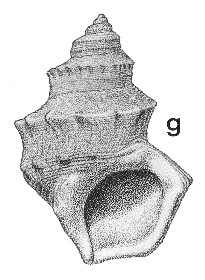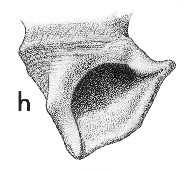
Revised descriptions of New Zealand Cenozoic Mollusca from Beu and Maxwell (1990)

 | Revised descriptions of New Zealand Cenozoic Mollusca from Beu and Maxwell (1990) | 
|
  (Pl. 20g): GS5517, J38/f6605, Tengawai River near Sutherlands, South Canterbury, Altonian (GNS) |
  (Pl. 20h): GS5517, J38/f6605, Tengawai River near Sutherlands, South Canterbury, Altonian (GNS) |
Beu & Maxwell (1990): Chapter 11; p. 189; pl. 20 g,h.
Synonymy: S. cincta var. C Hutton 1873b, p. 11; S. calcar Hutton 1886a, p. 335; S. subspinosa Marwick 1924b, p. 175; ?S. prior Finlay 1926b, p. 228
Classification: Struthiolariidae
Description: Rather small to moderate-sized for genus (height 25-55 mm), broadly ovate, spire gradate, about half total height. Protoconch depressed dome-shaped, of about 2.5 apparently smooth whorls, apex flattened. Teleoconch of 5-6.5 whorls, first 2 or 3 convex, then developing an angulation at about 0.6-0.7 whorl height that quickly becomes very prominent; some shells with a second, weaker angulation between shoulder and lower suture that becomes obsolete after a whorl or so. Last whorl with a prominent peribasal angulation, some shells with a weaker one a short distance below. Whorl sides convex or flat at first, strongly concave on adult; base flat or slightly concave, anterior end pointed. Spiral sculpture varying considerably in strength, commencing as 7 or 8 narrow, low, subequal cords, increasing steadily in number during growth, penultimate whorl with about 20-30 narrow cords, mostly subequal but including some noticeably weaker than others in some shells; some well preserved specimens with very fine interstitial threadlets. Last whorl with 15-25 similar spirals on base. Axial sculpture — apart from growth lines — commencing as numerous very small nodules on shoulder angulation, decreasing in number and increasing in strength during growth, penultimate whorl with 17-25, last whorl with 10-20 shoulder tubercles, in many shells becoming obsolete on last quarter-whorl. Tubercles sharp in some shells, bluntly triangular in others. Peribasal angle with more obscure nodules not corresponding in position or number to shoulder tubercles. Aperture ovate- trigonal, constricted anteriorly; columella twisted to right. Inner lip prominently calloused, less so in parietal region than below, callus not extending far above suture, strongly excavated over columella. Outer lip calloused to varying degree, prosocline and almost straight from suture to shoulder angle, slightly concave between whorl angles, strongly retracted from peribasal angulation to end of columella. Some specimens with a distinct, short spine at shoulder angle, its face shallowly grooved, but others lacking such a spine.
Comparison: This is by far the most widely recorded and apparently the longest-ranging New Zealand struthiolariid, although the vast majority of records are under the name Struthiolaria subspinosa rather than S. calcar. Marwick (1924b, p. 176) recognised the great similarity between these two nominal species but maintained that the presence of a spine (or "spur") on the outer lip of S. calcar warranted segregation from S. subspinosa, and this distinction has not been questioned by subsequent workers. However, large series of shells show a complete gradation between those with a well developed spine and those without any trace of such a feature, and it is clear that it varies as much as other sculptural features in this highly variable species. Specimens with the spine seem to represent a shallow-water phenotype, as they occur mainly in shellbeds and in the Southburn Sand. With some reluctance, S. subspinosa was regarded by Beu & Maxwell (1990) as a junior synonym of S. calcar. S. prior (Duntroonian, Waikaia, Southland) is probably another synonym of S. calcar (see Pl. 15a), as the alleged differences between the two taxa are neither very important nor — as far as can be ascertained from the limited material available of S. prior — particularly constant. S. lawsi (Otaian, Waiheke Island) is similar to S. calcar, but grows to a much larger size (more than 125 mm in height), and has fewer but stronger peripheral tubercles (about seven per whorl on later whorls). Some individuals have a prominent spine-like extension to the outer lip at the periphery as in S. calcar.
Distribution: Runangan, Northland; ?Duntroonian, Waitakian-Clifdenian, possibly younger (Waiauan?); "Oamaru" (type locality of S. calcar — possibly Ardgowan Shellbed, Altonian, the locality of Marwick's neotype); Southburn Sand, White Rock River, Altonian (type locality of S. subspinosa) and numerous other localities, particularly in the South Island. The upper stratigraphic limit of S. calcar is uncertain — specimens from "Nissen no. 1 shellbed", Clifden (Waiauan) resemble Altonian shells in shape and sculpture, but are much larger (height 80- 85 mm), a difference of doubtful taxonomic significance.
Cite this publication as: "A.G. Beu and J.I. Raine (2009). Revised
descriptions of New Zealand Cenozoic Mollusca from Beu and Maxwell (1990). GNS
Science miscellaneous series no. 27."
© GNS Science, 2009
ISBN
978-0-478-19705-1
ISSN 1177-2441
(Included with a PDF facsimile file
copy of New Zealand Geological Survey Paleontological Bulletin 58 in CD version
from: Publications Officer, GNS Science, P.O. Box 30368 Lower Hutt, New
Zealand)